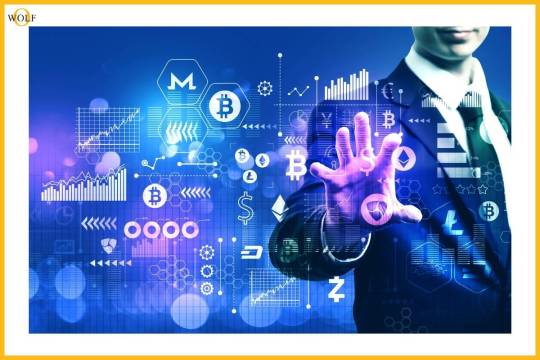Don't wanna be here? Send us removal request.
Text
Top 9 Leadership Qualities for the Business
https://businesswolfmagazine.com/wp-content/uploads/2024/08/1.Top-9-Leadership-Qualities-for-the-Business.jpg
In the dynamic world of business, leadership qualities are paramount for driving success, fostering innovation, and navigating challenges. Whether you’re leading a startup, a small business, or a large corporation, certain leadership qualities can set you apart and ensure your team’s sustained growth and achievement. This blog will explore the top nine leadership qualities essential for any business leader.
Top 9 leadership qualities essential for any business leader:
1. Visionary Thinking
A great leader possesses a clear vision for the future. Visionary thinking involves not only setting long-term goals but also inspiring others to share that vision. This quality allows leaders to steer their organizations toward a common objective, ensuring everyone is aligned and motivated.
Key Points:
Articulate a Clear Vision: Communicate your vision effectively to your team.
Inspire and Motivate: Encourage your team to buy into the vision and work towards it with passion.
Adapt and Refine: Be open to evolving your vision based on changing market dynamics and feedback.
2. Effective Communication

Communication is a cornerstone of leadership qualities. Leaders must be able to convey their ideas, expectations, and feedback clearly and concisely. Effective communication fosters a culture of transparency and trust, crucial for any successful business.
Key Points:
Active Listening: Show empathy and understand your team’s concerns.
Clear Instructions: Provide unambiguous instructions and constructive feedback.
Open Door Policy: Encourage open communication and be approachable.
3. Integrity
Integrity is the foundation of trust and credibility. Leaders with high ethical standards set the tone for their organization, ensuring that honesty and transparency are prioritized. This quality helps build a positive reputation, both internally and externally.
Key Points:
Lead by Example: Demonstrate ethical behavior in all your actions.
Build Trust: Foster a culture of honesty and accountability.
Maintain Consistency: Ensure your actions align with your values and promises.
4. Emotional Intelligence
Emotional intelligence (EI) is the ability to understand and manage your own emotions and those of others. High EI enables leaders to navigate complex interpersonal dynamics, resolve conflicts, and build strong, empathetic relationships with their team.
Key Points:
Self-Awareness: Recognize your own emotions and their impact on your behavior.
Empathy: Understand and respect the emotions and perspectives of others.
Social Skills: Build and maintain healthy relationships within your team.
5. Decisiveness
In the fast-paced business environment, leaders often need to make quick, informed decisions. Decisiveness involves assessing the situation, weighing the options, and making timely choices that drive the organization forward.
Key Points:
Analyze Thoroughly: Gather all relevant information before making a decision.
Be Confident: Trust your judgment and be decisive in your actions.
Learn from Mistakes: Accept and learn from any errors to improve future decision-making.
6. Resilience

Resilience is the ability to bounce back from setbacks and persist in the face of challenges. This quality is crucial for leaders, as it enables them to stay focused and motivated, even during tough times, ensuring their team remains positive and productive.
Key Points:
Stay Positive: Maintain an optimistic outlook and inspire your team to do the same.
Adaptability: Be flexible and ready to pivot strategies when necessary.
Perseverance: Keep pushing forward despite obstacles and setbacks.
7. Innovation
Innovative leaders are always looking for new ways to improve and grow their businesses. This quality involves fostering a culture of creativity and encouraging your team to think outside the box, leading to continuous improvement and competitive advantage.
Key Points:
Encourage Creativity: Create an environment where new ideas are welcomed and valued.
Stay Informed: Keep up with industry trends and technological advancements.
Risk-Taking: Be willing to take calculated risks to drive innovation.
8. Accountability
Accountability is about taking responsibility for your actions and decisions. Leaders who hold themselves and their team accountable create a culture of reliability and trust, which is essential for achieving business objectives.
Key Points:
Set Clear Expectations: Define roles and responsibilities clearly.
Follow Through: Ensure commitments are met and address any shortcomings promptly.
Own Mistakes: Admit and learn from your mistakes, setting an example for your team.
9. Empathy

Empathy is the ability to understand and share the feelings of others. Empathetic leaders build strong relationships with their team, fostering a supportive and collaborative work environment that enhances overall performance.
Key Points:
Be Approachable: Make yourself available to listen to your team’s concerns.
Show Genuine Concern: Take an active interest in your team’s well-being.
Supportive Leadership: Provide the necessary support and resources for your team to succeed.
Conclusion
Incorporating these leadership qualities into your management style can significantly impact your business’s success. From visionary thinking to empathy, each trait plays a crucial role in guiding your team towards achieving common goals. As a business leader, continually developing and refining these qualities will not only enhance your leadership capabilities but also contribute to a thriving and dynamic business environment.
By focusing on these top nine leadership qualities, you can inspire your team, drive innovation, and navigate the complexities of the business world with confidence and resilience.
Did you find this article helpful? Visit more of our blogs! Business Wolf Magazine
0 notes
Text
Origin of eLearning: 5 Unknown Facts

The digital age has brought about significant changes in how we approach education, with it becoming a cornerstone of modern learning practices. The rise of it has revolutionized the way we access, consume, and interact with educational content. But where did it all begin? Here, we delve into the origin, uncovering five unknown facts that highlight its journey and impact on education.
The Early Roots of eLearning
Before diving into the unknown facts, it’s essential to understand the basic history. The concept of it can be traced back to the 1960s when computer-based learning systems started to emerge. The University of Illinois is often credited with creating one of the first computer-based education systems in the 1960s, utilizing the PLATO (Programmed Logic for Automatic Teaching Operations) system. This was a pioneering step in the evolution of eLearning, setting the stage for the development of more sophisticated online education platforms.
1. The Military’s Pioneering Role in eLearning
One of the lesser-known facts about the origin of it is the significant role played by the military. In the mid-20th century, the U.S. military began exploring technology to improve training and education for its personnel. During World War II, the military used film and other multimedia tools to train soldiers, laying the groundwork for future digital learning initiatives.
In the 1960s and 1970s, the U.S. Department of Defense invested heavily in developing computer-based training programs. These programs were designed to provide standardized training across various branches of the military, ensuring that all personnel received consistent and effective education. The success of these early initiatives demonstrated the potential and spurred further advancements in the field.
2. The Role of Universities in Shaping eLearning
https://businesswolfmagazine.com/wp-content/uploads/2024/08/2.The-Impact-of-eLearning-on-Modern-Education-1.jpg
While the military’s involvement was crucial, universities also played a significant role in the development. In the 1960s, the University of Illinois pioneered the use of computers for education with its PLATO system. PLATO was one of the first systems to provide interactive learning experiences, allowing students to engage with educational content through a computer terminal.
The success of PLATO inspired other universities to explore the potential of computer-based education. By the 1980s, many higher education institutions had begun developing their own its platforms. These early systems were often rudimentary compared to today’s standards, but they paved the way for the sophisticated online learning environments we see today.
3. The Advent of the Internet and its Impact on eLearning
The emergence of the internet in the 1990s marked a turning point in the evolution. With the advent of the World Wide Web, educational content could be easily distributed and accessed by anyone with an internet connection. This democratization of information was a game-changer for education, making learning opportunities available to a global audience.
In 1999, the term “eLearning” was coined, reflecting the growing importance of electronic learning methods. The internet facilitated the development of online courses, virtual classrooms, and educational websites, significantly expanding its reach and impact it. The ability to deliver education online broke down geographical barriers and allowed learners to access high-quality education from anywhere in the world.
4. The Role of Learning Management Systems (LMS)
Another critical development in the history of it was the creation of Learning Management Systems (LMS). An LMS is a software application that provides the framework for managing all aspects of the learning process, including the delivery of content, tracking progress, and assessing performance.
The first LMS, known as FirstClass, was developed in the 1990s. It provided a platform for online collaboration and communication, allowing educators to create and deliver content more efficiently. Over the years, LMS technology has evolved significantly, with platforms like Moodle, Blackboard, and Canvas becoming integral to modern environments. These systems have streamlined the administration of it, making it more accessible and effective for both educators and learners.
5. The Influence of Open Educational Resources (OER)
The rise of Open Educational Resources (OER) has also played a crucial role in the development of it. OER are freely accessible, openly licensed educational materials that can be used for teaching, learning, and research. The concept of OER gained traction in the early 2000s, with initiatives like MIT’s OpenCourseWare project leading the way.
The availability of OER has greatly expanded its scope, providing educators and learners with a wealth of high-quality, cost-free educational resources. This movement towards open access has helped to democratize education, making it possible for anyone, regardless of their financial situation, to benefit from top-tier educational content. The proliferation of OER has been instrumental in the global spread, ensuring that learning opportunities are available to all.
The Impact of eLearning on Modern Education

Understanding the origin and evolution of it provides valuable insights into its profound impact on modern education. Today, it is an integral part of the educational landscape, offering numerous benefits that traditional classroom settings often cannot match.
1. Accessibility and Inclusivity
One of the most significant impacts of it is its ability to make education more accessible and inclusive. Online learning platforms can reach students in remote and underserved areas, providing them with opportunities that were previously unavailable. Additionally, accommodates diverse learning styles and needs, offering personalized learning experiences that can be tailored to individual preferences and abilities.
2. Flexibility and Convenience
It offers unparalleled flexibility and convenience, allowing students to learn at their own pace and on their own schedule. This is particularly beneficial for working professionals, parents, and others with busy lifestyles who may find it challenging to attend traditional classes. The flexibility of it also supports lifelong learning, enabling individuals to continue their education and professional development throughout their lives.
3. Cost-Effectiveness
Compared to traditional education, it can be more cost-effective. Online courses often have lower tuition fees, and there are no additional costs for commuting, housing, or physical materials. The availability of free and low-cost resources, such as OER, further reduces the financial barriers to education.
4. Global Collaboration and Networking
eLearning facilitates global collaboration and networking, connecting learners and educators from around the world. Virtual classrooms, discussion forums, and social media platforms enable students to engage with peers and instructors from diverse backgrounds, enriching their learning experiences and broadening their perspectives.
5. Continuous Innovation and Improvement
It is continually evolving, driven by advances in technology and educational research. Innovations such as artificial intelligence, virtual reality, and gamification are enhancing the effectiveness and engagement of online learning. These ongoing developments ensure that it remains at the forefront of educational practice, continually improving to meet the needs of modern learners.
The Future of eLearning
As we look to the future, it is clear that eLearning will continue to play a vital role in education. The ongoing advancements in technology, coupled with the growing demand for flexible and accessible learning options, will drive the evolution of it in the coming years. Here are a few trends and predictions for the future of eLearning:
1. Increased Use of Artificial Intelligence
Artificial intelligence (AI) has the potential to revolutionize it by providing personalized learning experiences, automating administrative tasks, and enhancing student support. AI-driven adaptive learning systems can tailor content to individual needs, helping students learn more effectively and efficiently.
2. Expansion of Virtual and Augmented Reality
Virtual reality (VR) and augmented reality (AR) technologies are already making their way into it, offering immersive and interactive learning experiences. These technologies can simulate real-world scenarios, allowing students to practice skills and explore environments in a safe and controlled setting.
3. Growth of Microlearning and Mobile Learning
Microlearning and mobile learning are poised to become increasingly popular in the landscape. Microlearning involves delivering content in small, manageable chunks, making it easier for learners to absorb and retain information. This approach is particularly effective for busy individuals who may only have short periods to dedicate to learning. Mobile learning, facilitated by the widespread use of smartphones and tablets, allows learners to access educational content on the go, making learning more flexible and convenient.
4. Emphasis on Lifelong Learning and Professional Development

As the job market continues to evolve, there will be a growing emphasis on lifelong learning and professional development. It has platforms that will increasingly offer courses and programs tailored to upskilling and reskilling workers to meet the demands of a rapidly changing economy. This trend will ensure that individuals can continuously update their knowledge and skills throughout their careers.
5. Integration of Social Learning
Social learning, which emphasizes learning through collaboration and interaction with others, will become more integrated into it platforms. Online discussion forums, group projects, and social media tools will facilitate peer-to-peer learning and create a sense of community among learners. This approach leverages the benefits of social interaction, which has traditionally been a strength of traditional schooling.
Conclusion: Embracing the Potential of eLearning
The origin and evolution of it reveal a rich history of innovation and adaptation. From its early roots in military training and university research to its current status as a global educational powerhouse, it has transformed the way we approach learning and teaching. The unknown facts about its development highlight the collaborative efforts and technological advancements that have shaped its growth.
As we move forward, it is essential to embrace the potential and leverage its strengths to create a more inclusive, flexible, and effective education system. By combining the benefits of it with the valuable aspects of traditional schooling, we can ensure that all learners have access to high-quality education that meets their needs and prepares them for the future.
The ongoing advancements in technology, the growing demand for lifelong learning, and the focus on accessibility and inclusivity will continue to drive the evolution of it. As educators, policymakers, and learners, we must stay informed about these trends and developments to make the most of the opportunities.
0 notes
Text
Top 5 EdTech Startups in APAC: 2025

The Asia-Pacific (APAC) region has emerged as a powerhouse for innovation in education technology or EdTech. The growing demand for accessible and quality education, coupled with rapid technological advancements, has paved the way for numerous EdTech startups in APAC. These startups are transforming the education landscape by introducing innovative solutions that cater to diverse learning needs. In this article, we will explore the top 5 EdTech startups in APAC for 2025, highlighting their unique contributions and the impact they are making in the education sector.
Top 5 EdTech startups in APAC for 2025:
1. BYJU’S (India)

Overview
BYJU’S, founded in 2011 by Byju Raveendran, is one of the leading EdTech startups in APAC. This Indian company has revolutionized the way students learn by offering engaging and interactive video lessons that cover a wide range of subjects. BYJU’S leverages a combination of personalized learning and technology to make education more effective and enjoyable.
Key Features
Interactive Video Lessons: BYJU’S provides high-quality video lessons that are designed to simplify complex concepts. These lessons are created by expert educators and are tailored to meet the learning needs of individual students.
Personalized Learning Paths: The platform uses artificial intelligence to create personalized learning paths for each student, ensuring that they receive the right content at the right time.
Gamified Learning: To keep students engaged, BYJU’S incorporates gamification elements into its lessons, making learning fun and interactive.
Impact
BYJU’S has made a significant impact on the education sector in India and beyond. With over 100 million registered users and more than 6.5 million paid subscribers, the platform has proven to be a valuable resource for students preparing for competitive exams and school curriculum. The company’s success has also attracted significant investment, further solidifying its position as a leader in EdTech startups in APAC.
2. Yuanfudao (China)
Overview
Yuanfudao is a Chinese EdTech startup in APAC that has gained prominence for its comprehensive online tutoring services. Founded in 2012, the company offers a wide range of educational resources, including live tutoring sessions, practice exercises, and study materials for K-12 students.
Key Features
Live Tutoring: Yuanfudao provides live tutoring sessions with experienced teachers, allowing students to receive real-time assistance with their studies.
Adaptive Learning: The platform uses adaptive learning technology to tailor educational content to the needs of individual students, ensuring personalized learning experiences.
Extensive Question Bank: Yuanfudao boasts a vast question bank with millions of practice questions, covering various subjects and difficulty levels.
Impact
Yuanfudao has become one of the most popular EdTech startups in APAC, with a user base of over 400 million students. The company’s focus on high-quality tutoring and personalized learning has made it a trusted resource for students and parents alike. Yuanfudao’s success has also led to significant funding, making it one of the highest-valued EdTech startups in APAC companies in the world.
3. Ruangguru (Indonesia)

Overview
Ruangguru, founded in 2014 by Belva Devara and Iman Usman, is an Indonesian EdTech startup in APAC that aims to democratize access to quality education. The platform offers a wide range of educational services, including online tutoring, video lessons, and practice tests for students of all ages.
Key Features
Online Tutoring: Ruangguru connects students with qualified tutors for personalized online tutoring sessions, covering a wide range of subjects.
Interactive Video Lessons: The platform provides engaging video lessons that simplify complex topics and make learning more enjoyable.
Practice Tests: Ruangguru offers a variety of practice tests and quizzes to help students prepare for exams and track their progress.
Impact
Ruangguru has made a significant impact on the education sector in Indonesia by providing affordable and accessible educational resources to millions of students. The platform’s user-friendly interface and comprehensive content have made it a popular choice for students and parents. Ruangguru’s success has also attracted substantial investment, enabling the company to expand its offerings and reach even more students.
4. Knewton (Japan)
Overview
Knewton, a Japanese EdTech startup in APAC founded in 2008, is known for its innovative adaptive learning technology. The platform uses data analytics and artificial intelligence to create personalized learning experiences for students, helping them achieve their academic goals more efficiently.
Key Features
Adaptive Learning Technology: Knewton’s adaptive learning technology analyzes student performance data to create personalized learning paths, ensuring that each student receives the right content at the right time.
Comprehensive Content Library: The platform offers a vast library of educational content, covering a wide range of subjects and grade levels.
Real-Time Feedback: Knewton provides real-time feedback to students, helping them identify their strengths and weaknesses and make improvements accordingly.
Impact
Knewton has gained recognition as one of the leading EdTech startups in APAC for its innovative approach to personalized learning. The platform’s adaptive learning technology has proven to be highly effective in improving student outcomes, making it a valuable resource for educators and students alike. Knewton’s success has also led to partnerships with educational institutions and publishers, further expanding its reach and impact.
5. Toppr (India)
https://businesswolfmagazine.com/wp-content/uploads/2024/08/3.5.toppr-Source-techstory.in_.jpg
Overview
Toppr, an Indian EdTech startup in APAC founded in 2013 by Zishaan Hayath and Hemanth Goteti, aims to provide personalized learning solutions for K-12 students. The platform offers a wide range of educational resources, including video lessons, practice tests, and live tutoring sessions.
Key Features
Personalized Learning: Toppr uses artificial intelligence to create personalized learning paths for students, ensuring that they receive the most relevant content based on their individual needs.
Extensive Question Bank: The platform offers a vast question bank with millions of practice questions, helping students prepare for exams and improve their understanding of various subjects.
Live Tutoring: Toppr provides live tutoring sessions with experienced educators, allowing students to receive real-time assistance with their studies.
Impact
Toppr has made a significant impact on the education sector in India by providing affordable and accessible educational resources to millions of students. The platform’s personalized learning approach has proven to be highly effective in improving student outcomes, making it a popular choice for students and parents. Toppr’s success has also attracted substantial investment, enabling the company to expand its offerings and reach even more students.
Conclusion
The APAC region is home to some of the most innovative and impactful EdTech startups in APAC in the world. Companies like BYJU’S, Yuanfudao, Ruangguru, Knewton, and Toppr are leading the way in transforming education through technology, providing personalized and engaging learning experiences for students of all ages. These top 5 EdTech startups in APAC for 2025 are making significant contributions to the education sector, helping millions of students achieve their academic goals and paving the way for a brighter future in education. As the demand for quality education continues to grow, these EdTech startups in APAC are well-positioned to play a crucial role in shaping the future of learning. By leveraging technology and innovative teaching methods, they are making education more accessible, effective, and enjoyable for students across the APAC region and beyond.
Did you find this article helpful? Visit more of our blogs! Business Wolf Magazine
0 notes
Text
Introduction to Cryptocurrency and Blockchain Technology
https://businesswolfmagazine.com/wp-content/uploads/2024/08/4.Introduction-to-Cryptocurrency-and-Blockchain-Technology.jpg
Cryptocurrency and blockchain technology have revolutionized the world of finance, offering new opportunities for decentralized and secure transactions. This comprehensive guide will explore the intricacies of these technologies, their applications, benefits, challenges, and the future potential they hold.
Introduction
Cryptocurrency and blockchain technology have gained significant attention and adoption over the past decade. They have not only created a new financial ecosystem but also introduced innovative ways of conducting transactions, managing assets, and securing data. This article delves into the origins, mechanisms, and implications of these transformative technologies.
The Origins of Cryptocurrency and Blockchain Technology
The story of cryptocurrency and blockchain technology began with the publication of a whitepaper titled “Bitcoin: A Peer-to-Peer Electronic Cash System” by an anonymous individual or group known as Satoshi Nakamoto in 2008. This document introduced Bitcoin, the first cryptocurrency, and the blockchain technology that underpins it.
Bitcoin was designed to offer a decentralized digital currency, free from the control of central banks and governments. The blockchain, a distributed ledger technology, was developed to ensure transparency, security, and immutability of transactions. This combination laid the foundation for a new era of digital finance.
Understanding Blockchain Technology

At its core, blockchain technology is a decentralized ledger that records transactions across a network of computers. Each transaction is grouped into a block, and these blocks are linked together in a chronological chain, hence the name blockchain. Here are the key components and features of blockchain technology:
Decentralization: Unlike traditional centralized systems, blockchain operates on a peer-to-peer network where all participants (nodes) have equal authority. This eliminates the need for intermediaries, reducing costs and increasing efficiency.
Immutability: Once a block is added to the blockchain, it cannot be altered or deleted. This immutability ensures the integrity and security of the data, making blockchain an ideal solution for recording sensitive information.
Transparency: All transactions recorded on the blockchain are visible to all participants in the network. This transparency fosters trust and accountability, which are crucial for financial transactions.
Consensus Mechanisms: To validate transactions and add new blocks to the blockchain, the network relies on consensus mechanisms like Proof of Work (PoW) and Proof of Stake (PoS). These mechanisms ensure that all participants agree on the state of the blockchain, preventing fraud and double-spending.
The Evolution of Cryptocurrencies
Since the launch of Bitcoin, the cryptocurrency landscape has expanded dramatically, with thousands of alternative cryptocurrencies, or altcoins, entering the market. Each cryptocurrency has its unique features, use cases, and underlying technology. Some notable examples include:
Ethereum: Launched in 2015, Ethereum introduced smart contracts, self-executing contracts with the terms directly written into code. This innovation enabled the development of decentralized applications (dApps) and decentralized finance (DeFi) platforms.
Ripple (XRP): Ripple focuses on facilitating fast and low-cost international money transfers. It aims to bridge the gap between traditional financial institutions and blockchain technology.
Litecoin: Created by Charlie Lee in 2011, Litecoin offers faster transaction confirmation times and a different hashing algorithm compared to Bitcoin. It is often considered the silver to Bitcoin’s gold.
Cardano: Developed with a research-driven approach, Cardano aims to provide a secure and scalable platform for the development of dApps and smart contracts. It uses a unique PoS consensus mechanism called Ouroboros.
Applications of Blockchain Technology Beyond Cryptocurrencies
While cryptocurrencies are the most well-known application of blockchain technology, the potential use cases extend far beyond digital currencies. Here are some of the diverse applications of blockchain technology:
Supply Chain Management: Blockchain can enhance transparency and traceability in supply chains by recording every transaction and movement of goods. This can help combat fraud, reduce inefficiencies, and improve consumer trust.
Healthcare: Blockchain can securely store and share patient records, ensuring data integrity and privacy. It can also streamline the management of pharmaceutical supply chains and clinical trials.
Voting Systems: Blockchain-based voting systems can provide a secure, transparent, and tamper-proof way to conduct elections, increasing voter trust and participation.
Intellectual Property: Blockchain can protect intellectual property rights by providing a transparent and immutable record of ownership and licensing agreements.
Real Estate: Blockchain can simplify property transactions by recording ownership, liens, and other relevant information on a decentralized ledger, reducing fraud and increasing efficiency.
Finance: Beyond cryptocurrencies, blockchain can streamline cross-border payments, reduce the risk of fraud, and provide a secure platform for issuing and trading digital securities.
Benefits of Cryptocurrency and Blockchain Technology
The rise of cryptocurrency and blockchain technology offers several significant benefits:
Decentralization: By eliminating the need for intermediaries, blockchain enables peer-to-peer transactions, reducing costs and increasing efficiency.
Security: Blockchain’s cryptographic algorithms and consensus mechanisms ensure the security and integrity of transactions and data, making it highly resistant to fraud and cyberattacks.
Transparency: The transparent nature of blockchain fosters trust and accountability, as all participants can view and verify transactions.
Immutability: Once recorded, data on the blockchain cannot be altered, providing a permanent and tamper-proof record of transactions.
Inclusion: Cryptocurrencies offer financial services to unbanked and underbanked populations, providing access to savings, loans, and payment systems.
Innovation: The development of smart contracts and dApps has opened up new possibilities for decentralized finance, governance, and digital identity management.
Challenges and Limitations of Cryptocurrency and Blockchain Technology

Despite the numerous advantages, cryptocurrency and blockchain technology face several challenges and limitations:
Scalability: As the number of transactions on a blockchain increases, the network can become congested, leading to slower transaction times and higher fees. Scaling solutions, such as the Lightning Network for Bitcoin and sharding for Ethereum, are being developed to address this issue.
Regulation: The regulatory environment for cryptocurrencies varies significantly across countries. While some nations have embraced the technology, others have imposed strict regulations or outright bans. Regulatory uncertainty can hinder adoption and innovation.
Energy Consumption: The PoW consensus mechanism, used by Bitcoin and other cryptocurrencies, requires significant computational power and energy. This has raised concerns about the environmental impact of cryptocurrency mining.
Security: While blockchain technology is inherently secure, vulnerabilities can exist in the software and protocols used to interact with the blockchain. Hacks and exploits can result in significant financial losses.
Adoption: For blockchain technology to reach its full potential, widespread adoption is necessary. This requires collaboration between governments, businesses, and individuals, as well as the development of user-friendly interfaces and applications.
Investing in Cryptocurrencies
Investing in cryptocurrencies can be highly rewarding but also comes with substantial risks. Here are some key considerations for potential investors:
Research: Thorough research is essential before investing in any cryptocurrency. Understand the technology, the team behind the project, market trends, and potential use cases.
Diversification: Diversifying your investment portfolio across different cryptocurrencies can help spread risk and increase the potential for returns.
Risk Management: Given the volatility of cryptocurrencies, it’s crucial to manage risk by setting stop-loss orders, only investing what you can afford to lose, and staying informed about market developments.
Security: Use reputable wallets and exchanges, enable two-factor authentication, and consider hardware wallets for long-term storage to protect your assets from theft and hacks.
Regulatory Considerations: Stay informed about the regulatory environment in your country. Changes in regulations can impact the value and legality of cryptocurrencies.
The Future of Cryptocurrency and Blockchain Technology

The future of cryptocurrency and blockchain technology holds immense potential, with several trends and developments shaping the landscape:
Increased Adoption: As awareness and understanding of cryptocurrencies and blockchain technology grow, adoption is likely to increase. More businesses, institutions, and individuals are expected to integrate these technologies into their operations.
Regulatory Clarity: Clear and consistent regulations will be crucial for the continued growth of the cryptocurrency market. Regulatory frameworks that protect investors while fostering innovation will be essential.
Technological Advancements: Ongoing technological developments, such as improvements in blockchain scalability, interoperability, and privacy, will enhance the functionality and appeal of cryptocurrencies and blockchain technology.
Integration with Traditional Finance: The lines between traditional finance and cryptocurrencies are expected to blur, with more financial institutions offering cryptocurrency services and integrating blockchain technology into their operations.
Environmental Considerations: The environmental impact of cryptocurrency mining, particularly Bitcoin, has been a topic of concern. Innovations in energy-efficient consensus mechanisms and increased use of renewable energy can address these issues.
Decentralized Finance (DeFi): DeFi platforms are likely to continue growing, offering new financial products and services that operate outside traditional financial systems. This could democratize access to financial services and reduce costs.
Central Bank Digital Currencies (CBDCs): In response to the rise of cryptocurrencies, central banks are exploring the issuance of digital currencies. CBDCs aim to combine the benefits of digital currencies with the stability and trust of traditional fiat currencies.
Conclusion
Cryptocurrency and blockchain technology have fundamentally changed the way we think about finance, transactions, and data security. From the creation of Bitcoin to the development of thousands of altcoins and the rise of decentralized applications, these technologies continue to evolve and shape the future.
Understanding the intricacies of cryptocurrency and blockchain technology is essential for navigating this rapidly changing landscape. Whether you are an investor, developer, or enthusiast, staying informed and adapting to new developments will be key to leveraging the opportunities these technologies offer.
0 notes
Text
CryptoCurrencies in 2025: An In-Depth Analysis

The world of cryptocurrencies continues to evolve at a rapid pace, with new innovations and trends shaping the landscape every year. As we step into 2025, several cryptocurrencies have emerged as leaders in the market, offering unique features, strong communities, and promising potential. In this comprehensive guide, we will explore the top 7 cryptocurrencies in 2025, delving into their backgrounds, technologies, use cases, and market performances.
Top 7 cryptocurrencies in 2025:
1. Bitcoin (BTC)
Bitcoin, often referred to as the king of cryptocurrencies in 2025, remains at the forefront of the digital currency revolution in 2025. Launched in 2009 by the mysterious Satoshi Nakamoto, Bitcoin introduced the world to blockchain technology and decentralized finance.
Key Features:
Decentralization: Bitcoin operates on a peer-to-peer network without the need for a central authority.
Security: Its blockchain is secured by a robust Proof of Work (PoW) consensus mechanism.
Finite Supply: The total supply is capped at 21 million BTC, contributing to its scarcity and value proposition.
Use Cases:
Digital Gold: Bitcoin is often considered a store of value, similar to gold.
Cross-Border Payments: It facilitates fast and low-cost international transactions.
Hedge Against Inflation: Investors view Bitcoin as a hedge against fiat currency devaluation.
Market Performance: In 2025, Bitcoin will continue to dominate the market with a significant market capitalization. Its price stability and growing institutional adoption make it a cornerstone of the cryptocurrency ecosystem.
2. Ethereum (ETH)

Ethereum, the second-largest cryptocurrency by market capitalization, has established itself as a leading platform for decentralized applications (dApps) and smart contracts since its launch in 2015 by Vitalik Buterin.
Key Features:
Smart Contracts: Ethereum’s smart contract functionality allows developers to build and deploy decentralized applications.
Ethereum 2.0: The ongoing upgrade to Ethereum 2.0 aims to enhance scalability, security, and energy efficiency through the transition to a Proof of Stake (PoS) consensus mechanism.
DeFi Ecosystem: Ethereum is the backbone of the decentralized finance (DeFi) movement, hosting numerous DeFi platforms and protocols.
Use Cases:
Decentralized Applications: Ethereum powers a wide range of dApps, including decentralized exchanges (DEXs), lending platforms, and NFT marketplaces.
Token Issuance: It supports the creation of various tokens through standards like ERC-20 and ERC-721.
Decentralized Finance: Ethereum enables users to engage in lending, borrowing, and yield farming without intermediaries.
Market Performance: Ethereum’s market performance in 2025 reflects its critical role in the blockchain ecosystem. Its transition to Ethereum 2.0 has boosted investor confidence, driving demand and usage.
3. Binance Coin (BNB)
Binance Coin, the native cryptocurrency of the Binance ecosystem, has grown significantly since its introduction in 2017 by the Binance cryptocurrency exchange.
Key Features:
Utility Token: BNB is used to pay for transaction fees on the Binance exchange, offering discounts to users.
Binance Smart Chain: Binance Coin powers the Binance Smart Chain (BSC), a blockchain platform for developing smart contracts and dApps.
Token Burn: Binance conducts quarterly token burns to reduce the total supply of BNB, potentially increasing its value.
Use Cases:
Exchange Fees: BNB holders enjoy reduced trading fees on the Binance exchange.
DeFi and dApps: BNB is used within the Binance Smart Chain ecosystem for various decentralized finance applications.
Payment Method: It can be used for payments, travel bookings, and more through various partnerships.
Market Performance: In 2025, Binance Coin remains a top-performing cryptocurrency, bolstered by the growth of the Binance exchange and the expanding BSC ecosystem. Its utility and strong community support contribute to its sustained demand.
4. Cardano (ADA)

Cardano, founded by Charles Hoskinson, a co-founder of Ethereum, has positioned itself as a third-generation blockchain platform focused on scalability, interoperability, and sustainability.
Key Features:
Proof of Stake: Cardano uses a unique PoS consensus mechanism called Ouroboros.
Research-Driven Development: Cardano’s development is based on peer-reviewed research and formal methods.
Interoperability: The platform aims to facilitate seamless interaction with other blockchains.
Use Cases:
Smart Contracts: Cardano supports the creation and execution of smart contracts.
Decentralized Applications: Developers can build dApps on the Cardano blockchain.
Identity Management: Cardano is exploring solutions for digital identity verification and management.
Market Performance: Cardano’s focus on rigorous research and development has earned it a reputation for reliability and innovation. its growing ecosystem and partnerships have solidified its position among the top cryptocurrencies in 2025.
5. Solana (SOL)
Solana is known for its high-performance blockchain, capable of processing thousands of transactions per second. Founded by Anatoly Yakovenko, Solana aims to provide fast, secure, and scalable decentralized applications and crypto-currencies.
Key Features:
High Throughput: Solana’s Proof of History (PoH) consensus mechanism enables high transaction throughput.
Low Fees: The platform offers low transaction fees, making it attractive for developers and users.
Ecosystem Growth: Solana supports a wide range of dApps, from DeFi to NFTs.
Use Cases:
DeFi Platforms: Solana hosts numerous DeFi projects offering lending, borrowing, and trading services.
NFT Marketplaces: The platform is popular for NFT creation and trading due to its low fees and high speed.
Scalable dApps: Developers build scalable dApps that require high transaction throughput.
Market Performance: In 2025, Solana’s market performance reflects its strong technological foundation and expanding ecosystem. Its ability to handle high transaction volumes with low latency has attracted significant interest from developers and investors.
6. Polkadot (DOT)
Polkadot, created by Dr. Gavin Wood, another Ethereum co-founder, aims to enable different blockchains to transfer messages and value in a trust-free fashion; sharing their unique features while pooling their security.
Key Features:
Interoperability: Polkadot’s relay chain allows different blockchains (parachains) to communicate and share security.
Scalability: The platform’s design enables parallel processing of multiple transactions across chains.
Governance: DOT token holders have a say in the governance and future direction of the network.
Use Cases:
Cross-Chain Communication: Polkadot facilitates the seamless transfer of data and assets across different blockchains.
Custom Blockchains: Developers can create customized blockchains tailored to specific needs.
DeFi and dApps: Polkadot supports various DeFi applications and decentralized platforms.
Market Performance: Polkadot’s innovative approach to interoperability and scalability has made it a leading player in the blockchain space. In 2025, its growing ecosystem of parachains and robust governance model continue to drive its success.
7. Chainlink (LINK)

Chainlink is a decentralized oracle network that enables smart contracts on various blockchains to securely interact with real-world data and external APIs. Launched by Sergey Nazarov and Steve Ellis, Chainlink has become essential for the DeFi ecosystem.
Key Features:
Decentralized Oracles: Chainlink provides reliable and tamper-proof data feeds for smart contracts.
Cross-Chain Compatibility: It supports interoperability between different blockchain networks.
Secure Data Provision: Chainlink’s decentralized network of oracles ensures the accuracy and security of data.
Use Cases:
DeFi Platforms: Chainlink oracles provide crucial data for DeFi applications, such as price feeds and interest rates.
Insurance: Smart contracts can use Chainlink to access real-world data for triggering insurance payouts.
Supply Chain: Chainlink enables blockchain-based supply chain solutions to interact with external data sources.
Market Performance: Chainlink’s role as a critical infrastructure provider for decentralized applications has cemented its position as a top cryptocurrency. In 2025, its continued integration with various blockchain networks and real-world applications underscores its importance.
Conclusion
The top 7 cryptocurrencies in 2025 represent a diverse array of technologies, use cases, and market positions. Bitcoin and Ethereum continue to lead the pack, while newer entrants like Solana, Cardano, and Polkadot showcase the innovation and evolution within the cryptocurrency space. Binance Coin and Chainlink further demonstrate the growing utility and integration of cryptocurrencies into various aspects of the digital economy.
As the cryptocurrency landscape continues to mature, these top 7 cryptocurrencies in 2025 are poised to play significant roles in shaping the future of decentralized finance, digital identity, and blockchain technology. Investors, developers, and enthusiasts should keep a close eye on these leading cryptocurrencies in 2025 as they navigate the ever-changing world of digital assets.
Did you find this article helpful? Visit more of our blogs! Business Wolf Magazine
1 note
·
View note
Text
10 Important Equipment Required for a Nutrition Center

The aim of the Nutrition Centre is to offer you practical dietary strategies that can reduce your risks of developing health issues such as heart disease, diabetes, and cancer, and ultimately help you improve the way of your life. A nutrition center should be carefully planned and the right equipment to ensure that clients receive the best services. The right tools are essential for providing accurate assessments, effective treatments, and comprehensive nutritional support.
This article will guide you through the ten most important pieces of equipment required for a nutrition center, ensuring your facility is well-equipped to meet the needs of your clients.
10 most important pieces of equipment required for a nutrition center:
1. Body Composition Analyzer
A body composition analyzer is a cornerstone of any nutrition center. This equipment measures various components of body composition, including fat mass, muscle mass, and water percentage. It provides a comprehensive analysis that helps nutritionists tailor diet and exercise programs to individual needs. Popular models, such as the InBody and Tanita, offer detailed reports that can track progress over time. A Nutrition Center must have a reliable body composition analyzer to provide accurate assessments of clients’ body fat, muscle mass, and overall health metrics.
2. Calorimeter
Calorimeters are essential for measuring the metabolic rate of clients. Understanding how many calories a person burns at rest (Basal Metabolic Rate or BMR) and during activity helps nutritionists create personalized diet plans. Equipment like the COSMED K5 or the Parvo Medics TrueOne 2400 provides precise measurements necessary for effective nutritional guidance. Using a calorimeter in your Nutrition Center can accurately determine the caloric needs of your clients, ensuring tailored diet plans that promote optimal health.
3. Blood Pressure Monitor

Monitoring blood pressure is critical for clients with cardiovascular concerns or those at risk of hypertension. A reliable blood pressure monitor helps track and manage these conditions effectively. Automated devices like the Omron Platinum Blood Pressure Monitor offer accurate and consistent readings, which are crucial for assessing the impact of dietary changes on cardiovascular health. A Nutrition Center should always have a blood pressure monitor to help track and manage clients’ cardiovascular health effectively.
4. Glucometer
For clients with diabetes or those at risk of developing it, monitoring blood glucose levels is essential. A glucometer provides quick and accurate readings, enabling nutritionists to adjust dietary recommendations accordingly. Devices like the Accu-Chek Guide or the FreeStyle Libre are popular choices for their ease of use and reliability.Equipping your Nutrition Center with a reliable glucometer is vital for managing and monitoring clients’ blood sugar levels effectively.
5. Professional Kitchen Appliances
A well-equipped kitchen is crucial for any nutrition center, particularly if you plan to offer cooking classes or prepare sample meals. Essential appliances include high-quality blenders, food processors, ovens, and stovetops. Brands like Vitamix, Cuisinart, and KitchenAid provide durable and efficient equipment that can handle the demands of busy nutrition. Professional kitchen appliances are a must-have in any Nutrition Center to prepare healthy meals and conduct cooking classes.
6. Dietary Software
Dietary software helps track clients’ nutritional intake and manage their dietary plans. Programs like NutriAdmin, Cronometer, and MyFitnessPal offer comprehensive features that allow nutritionists to create, monitor, and adjust meal plans efficiently. These tools are invaluable for maintaining accurate records and providing data-driven recommendations. Utilizing dietary software in your Nutrition Center can streamline the process of creating and monitoring personalized meal plans for your clients.
7. Anthropometric Measurement Tools

These tools, including calipers, tape measures, and stadiometers, are essential for assessing body measurements such as skinfold thickness, waist circumference, and height. Accurate anthropometric data is crucial for evaluating nutritional status and tracking progress. Brands like Seca and Harpenden offer high-quality measurement tools trusted by professionals. Anthropometric measurement tools are indispensable in a Nutrition Center for assessing and tracking clients’ physical changes over time.
8. Food Sensitivity Testing Kits
Food sensitivity and allergy testing kits are valuable for identifying adverse reactions to certain foods. Understanding a client’s sensitivities allows for more precise dietary recommendations. Kits from companies like EverlyWell and YorkTest provide reliable results that can significantly improve personalized nutrition plans. Food sensitivity testing kits in your Nutrition Center can help identify and manage clients’ adverse reactions to various foods
9. Educational Materials and Resources
Providing clients with educational materials, such as pamphlets, books, and online resources, enhances their understanding of nutrition and healthy eating habits. Resources from organizations like the Academy of Nutrition and Dietetics or Healthline offer credible and accessible information that can support your clients’ journeys. Educational materials are crucial in a Nutrition Center to empower clients with knowledge about nutrition and healthy lifestyle choices.
10. Comfortable Consultation Space
https://businesswolfmagazine.com/wp-content/uploads/2024/08/6.10.-Comfortable-Consultation-Space.jpg
Lastly, a comfortable and welcoming consultation space is essential for effective client interactions. This includes ergonomic furniture, appropriate lighting, and a calm atmosphere. Investing in quality furniture and decor from brands like Herman Miller and IKEA can create a professional yet inviting environment. Creating a comfortable consultation space in your Nutrition Center is vital for fostering positive and productive client interactions.
Nutritionists and dietitians are health professionals who use their expert knowledge in the field of food and nutrition to help people make positive lifestyle changes. These practitioners have training in the science of nutrition, which they translate into practical solutions and open nutritional centers for clients to assist them in reaching their health goals.
If you are a dietitian or nutritionist, then you are likely familiar with many of the tools listed above that are used in your nutrition center.Setting up a nutrition center with the right equipment is crucial to provide top-notch services. Investing in the right equipment not only enhances the quality of service but also ensures your clients get the best possible care
Did you find this article helpful? Visit more of our blogs! Business Wolf Magazine
0 notes
Text
Top 12 Mobile Apps for Weight Loss

In today’s digital age, technology has made it easier than ever to stay on top of our health and fitness goals. Weight Loss apps help you consistently track calories and exercise is an effective strategy for weight management. Many mobile apps are designed after Covid-19. They help track your progress, give motivation, and offer expert advice.
Here, we’ve compiled a list of the top 12 apps for weight loss that can help you achieve your goals.
1. MyFitnessPal
Key Features:
Extensive food database
Barcode scanner for easy food tracking
Personalized diet plans
MyFitnessPal is a standout among apps for weight loss due to its comprehensive food database and user-friendly interface. With over 11 million foods listed, it allows users to track their daily caloric intake with precision.The barcode scanner feature simplifies logging packaged foods, making it easier to stick to your diet plan.
2. Lose It!

Key Features:
Goal-based weight loss plans
Food tracking and meal planning
Community support
Lose It! offers a personalized approach to weight loss. It is one of the apps for weight loss which is useful for setting a target weight and timeframe. This app creates a daily calorie budget to help you achieve your goals.Its food tracking feature is complemented by a meal planning tool, ensuring you stay on track. The app also boasts a vibrant community for support and motivation.
3. Noom
Key Features:
Psychological approach to weight loss
Personalized coaching
In-app lessons and activities
Noom takes a unique approach by focusing on the psychological aspects of weight loss. It combines personalized coaching with daily lessons and activities to help users develop healthier habits. This is one of the apps for weight loss that not only helps to reduce weight but also provides sustainable lifestyle changes that last.
4. Weight Watchers (WW)
Key Features:
Points-based system
Personalized meal plans
Access to WW community
Weight Watchers, now known as WW, is one of the most well-known names in weight loss. This is one of the unique apps for weight loss that uses a points-based system to simplify tracking food intake. It also provides personalized meal plans and access to a supportive community, making it a comprehensive tool for those serious about losing weight.
5. Fitbit
Key Features:
Activity and sleep tracking
Heart rate monitoring
Integration with Fitbit devices
Fitbit is among one of the top and most powerful apps for weight loss It is a strong companion to its wearable devices, but it also functions well on its own. It tracks your daily activity, sleep, and heart rate, providing a holistic view of your health. By setting weight loss goals, the app helps you monitor your progress and stay motivated.
6. Cronometer
https://businesswolfmagazine.com/wp-content/uploads/2024/08/7.6.-Cronometer-Source-play.google.com-.jpg
Key Features:
Detailed nutrient tracking
Customizable food diary
Integration with fitness devices
Cronometer stands out among apps for weight loss due to its emphasis on nutrient tracking. Beyond just calories, it helps users monitor their intake of vitamins, minerals, and other nutrients. This detailed approach can be particularly beneficial for those with specific dietary needs.
7. Yazio
Key Features:
Personalized meal plans
Recipe suggestions
Fasting tracker
This app offers a comprehensive approach to weight loss with personalized meal plans and recipe suggestions. Yazio comes among apps for weight loss which includes a fasting tracker for those who practice intermittent fasting.Its user-friendly interface makes it easy to stay on top of your diet and fitness goals.
8. SparkPeople
Key Features:
Robust community support
Fitness and diet tracking
Motivational articles and videos
SparkPeople combines fitness and diet tracking with a strong community aspect. Users can join groups, participate in challenges, and access a wealth of motivational content. It is one of the apps for weight loss that supports networks that can be incredibly valuable for staying committed to your weight loss journey.
9. Fooducate
Key Features:
Food grading system
Personalized nutrition tips
Barcode scanner
Fooducate helps users make healthier food choices with its unique food grading system. Each food item is given a grade based on its nutritional content, helping you quickly identify the healthiest options. The app also provides personalized nutrition tips and a barcode scanner for easy food tracking which makes it a reliable weight loss app.
10. My Diet Coach
Key Features:
Visual weight tracker
Daily challenges
Motivational tips and reminders
My Diet Coach is one of the apps for weight loss that focuses on keeping users motivated with daily challenges and tips. Its visual weight tracker helps you see your progress, while reminders and motivational quotes keep you inspired. The app’s fun and engaging approach makes weight loss feel more like a game than a chore.
11. Lifesum

Key Features:
Diet plans and recipes
Macro tracking
Health test and ratings
Lifesum offers a variety of diet plans and recipes tailored to your goals. It tracks your macronutrient intake, ensuring you get the right balance of proteins, fats, and carbs. The app also includes a health test to provide personalized recommendations and ratings based on your habits. These features make it a better weight loss app in terms of diet planning
12. HealthyOut
Key Features:
Healthy restaurant recommendations
Customizable dietary preferences
Nutrition information
HealthyOut comes as one of the apps for weight loss which is useful for people who eat outside a lot.The app recommends healthy dishes at restaurants based on your dietary preferences. It provides nutrition information for menu items, helping you make smarter choices when dining out.
The right app for weight loss can significantly impact your success. Whether you need detailed nutrient tracking, personalized coaching, or community support, there’s an app out there that can meet your needs. These are some of the best apps for weight loss that individuals can use to improve their health. In the end, the success of a weight loss app depends upon the user’s engagement, consistency, and commitment to making a healthier lifestyle. It’s also worth noting that individual preferences play a role as well.
Did you find this article helpful? Visit more of our blogs! Business Wolf Magazine
0 notes
Text
Are Our Buildings Safe? 5 Steps to Maintain a Safe Workplace

In today’s fast-paced and dynamic work environment, ensuring the safety of buildings and creating a safe workplace is paramount for employers, employees, and stakeholders alike. A safe workplace is not only a legal obligation but also a critical factor in enhancing productivity, employee satisfaction, and overall business success. This comprehensive article delves into the importance of maintaining building safety and outlines five crucial steps to ensure a safe workplace.
The Importance of Building Safety
Legal and Regulatory Compliance
Adhering to safety regulations and building codes is mandatory for all businesses. Regulatory bodies like OSHA (Occupational Safety and Health Administration) in the United States set stringent guidelines to ensure that workplaces are free from hazards that could cause harm to employees. Non-compliance can lead to severe penalties, legal repercussions, and damage to the organization’s reputation.
Protecting Human Lives
The primary goal of maintaining a safe workplace is to protect human lives. Employees spend a significant portion of their day within the workplace, making it essential to create an environment where they feel secure. Accidents, injuries, and fatalities can be prevented by adhering to safety standards and continuously improving safety protocols.
Enhancing Productivity and Morale
A safe workplace directly impacts employee productivity and morale. When employees feel safe, they are more likely to be engaged, motivated, and focused on their tasks. Conversely, a workplace with safety concerns can lead to stress, anxiety, and decreased productivity. By prioritizing safety, businesses can foster a positive work environment that promotes efficiency and job satisfaction.
Reducing Financial Liabilities

Workplace accidents and injuries can result in substantial financial liabilities for businesses. Medical expenses, compensation claims, legal fees, and repair costs can quickly accumulate, affecting the company’s bottom line. Implementing robust safety measures helps mitigate these risks, ultimately saving money and resources in the long run.
5 Steps to Maintaining a Safe Workplace
1. Conduct Regular Safety Audits
Regular safety audits are crucial for identifying potential hazards and ensuring compliance with safety standards. These audits should be conducted by trained professionals who can thoroughly assess the building’s infrastructure, equipment, and safety protocols.
Identifying Potential Hazards
During a safety audit, inspectors examine various aspects of the workplace, including structural integrity, electrical systems, fire safety measures, and emergency exits. Identifying potential hazards allows businesses to take proactive measures to address them before they escalate into serious issues.
Ensuring Compliance
Safety audits also involve reviewing compliance with local, state, and federal regulations. Inspectors check for adherence to building codes, fire safety standards, and occupational health and safety guidelines. By ensuring compliance, businesses can avoid legal troubles and create a safer work environment.
Continuous Improvement
Regular audits provide valuable insights into areas that require improvement. Businesses can use audit findings to update safety protocols, invest in necessary repairs, and enhance overall workplace safety. Continuous improvement is key to maintaining a safe workplace over time.
2. Implement Comprehensive Safety Training Programs
Educating employees about safety protocols and best practices is essential for creating a culture of safety within the workplace. Comprehensive safety training programs equip employees with the knowledge and skills needed to identify and respond to potential hazards effectively.
Orientation and Onboarding
Safety training should begin during the orientation and onboarding process. New employees should receive detailed instructions on emergency procedures, evacuation plans, and the proper use of safety equipment. Providing this information from the outset sets the tone for a safe workplace.
Ongoing Training and Refresher Courses
Safety training should be an ongoing process. Regular training sessions and refresher courses help reinforce safety protocols and keep employees updated on any changes to safety procedures. Interactive training methods, such as hands-on drills and simulations, can enhance learning and retention.
Specialized Training
Certain industries and job roles may require specialized safety training. For example, construction workers need training on working at heights, while laboratory personnel require instruction on handling hazardous materials. Providing tailored training ensures that employees are well-prepared for the specific risks associated with their roles.
3. Maintain Proper Equipment and Infrastructure
Ensuring that all equipment and infrastructure are in good working condition is critical for maintaining a safe workplace. Regular maintenance, timely repairs, and proper upgrades contribute to the overall safety of the building and its occupants.
Regular Maintenance Schedules

Establishing regular maintenance schedules for equipment and infrastructure helps prevent unexpected failures and accidents. This includes routine checks on HVAC systems, electrical wiring, plumbing, and fire safety equipment. Scheduled maintenance reduces the risk of malfunctions and extends the lifespan of critical systems.
Timely Repairs and Upgrades
When issues are identified, timely repairs are essential to prevent them from becoming larger problems. Additionally, upgrading outdated or worn-out equipment can enhance safety and efficiency. Investing in modern safety technologies, such as automated fire detection systems and advanced security cameras, can provide an added layer of protection.
Safety Inspections
Regular safety inspections should be conducted to identify any wear and tear or potential hazards. Inspectors can assess the condition of safety equipment, such as fire extinguishers, emergency lighting, and exit signs. Ensuring that these components are in optimal condition is vital for maintaining a safe workplace.
4. Promote a Safety-First Culture
Creating a safety-first culture requires active participation and commitment from all levels of the organization. Leadership plays a crucial role in setting the tone for safety, while employee involvement ensures that safety practices are embraced and upheld throughout the workplace.
Leadership Commitment
Leaders and managers must prioritize safety and demonstrate their commitment through actions and policies. This includes allocating resources for safety initiatives, addressing safety concerns promptly, and leading by example. When employees see that leadership values safety, they are more likely to follow suit.
Employee Involvement
Encouraging employee involvement in safety initiatives fosters a sense of ownership and responsibility. Establishing safety committees, conducting regular safety meetings, and inviting feedback from employees can lead to valuable insights and improvements. Recognizing and rewarding employees for their contributions to safety can also motivate others to participate actively.
Clear Communication
Effective communication is essential for promoting a safety-first culture. Clear and transparent communication channels ensure that safety information is disseminated promptly and accurately. This includes sharing safety updates, incident reports, and best practices. Encouraging open dialogue about safety concerns helps address issues before they escalate.
5. Emergency Preparedness and Response Planning
Being prepared for emergencies is a fundamental aspect of maintaining a safe workplace. Comprehensive emergency preparedness and response planning ensure that employees know how to react in various emergency situations, minimizing risks and enhancing safety.
Emergency Plans and Procedures
Developing detailed emergency plans and procedures is the first step in emergency preparedness. These plans should cover a range of scenarios, including fires, natural disasters, medical emergencies, and security threats. Clear and concise procedures provide employees with step-by-step instructions on how to respond effectively.
Regular Drills and Exercises

Conducting regular emergency drills and exercises helps familiarize employees with emergency procedures and ensures a swift and coordinated response. Evacuation drills, fire drills, and first aid training sessions are valuable tools for enhancing preparedness. Drills should be conducted periodically and evaluated to identify areas for improvement.
Access to Emergency Resources
Ensuring that emergency resources are readily available is critical for effective response. This includes maintaining well-stocked first aid kits, fire extinguishers, and emergency communication systems. Employees should be trained on the proper use of these resources to maximize their effectiveness during emergencies.
Conclusion
Maintaining a safe workplace is an ongoing process that requires dedication, vigilance, and continuous improvement. By conducting regular safety audits, implementing comprehensive training programs, maintaining equipment and infrastructure, promoting a safety-first culture, and preparing for emergencies, businesses can create a safe environment that protects employees and enhances productivity. Prioritizing safety not only fulfills legal obligations but also demonstrates a commitment to the well-being of all stakeholders. As we move forward, let us remember that the foundation of a successful business is a safe workplace where everyone can thrive.
Did you find this article helpful? Visit more of our blogs! Business Wolf Magazine
0 notes
Text
Labor Law Compliance and Regulations: A Comprehensive Guide

Source: Image-by-photobyphotoboy
In today’s complex business environment, understanding labor law compliance and regulations is essential for employers and employees alike. Compliance with labor laws not only ensures a fair workplace but also protects organizations from legal repercussions. This article explores the various aspects of labor law compliance and regulations, providing insights into their importance, key components, and strategies for effective implementation.
What Are Labor Laws?
Labor laws are legal frameworks that govern the relationship between employers and employees. They cover a broad range of issues, including wages, working hours, safety standards, employee rights, and unionization. The primary aim of labor laws is to protect the rights of workers while providing a structured environment for businesses to operate.
Importance of Labor Law Compliance and Regulations
Protection of Employee Rights: Labor laws are designed to protect the rights of employees, ensuring they receive fair treatment in the workplace. Compliance with these laws helps safeguard against discrimination, harassment, and unfair labor practices.
Minimizing Legal Risks: Non-compliance with labor laws can lead to serious legal consequences, including lawsuits, fines, and reputational damage. By adhering to labor law compliance and regulations, organizations can minimize these risks and avoid costly legal battles.
Enhancing Employee Morale: A workplace that prioritizes labor law compliance fosters a positive work environment. Employees are more likely to be motivated and productive when they know their rights are respected and upheld.
Reputation Management: Organizations known for their compliance with labor laws are viewed more favorably by customers, potential employees, and the community. A strong reputation for fairness can enhance an organization’s brand image and attract top talent.
Key Components of Labor Law Compliance and Regulations
Understanding the key components of labor law compliance and regulations is crucial for organizations. Here are some of the fundamental aspects:
1. Wage and Hour Laws
Wage and hour laws govern the minimum wage, overtime pay, and working hours. These laws ensure that employees are compensated fairly for their work. Compliance requires employers to maintain accurate records of hours worked and ensure that wages are paid according to legal standards.
2. Workplace Safety Regulations
Safety regulations, such as those established by the Occupational Safety and Health Administration (OSHA) in the United States, set standards for workplace safety. Employers are required to provide a safe working environment and comply with safety training and reporting requirements. Failure to comply with these regulations can result in severe penalties.
3. Anti-Discrimination Laws
Anti-discrimination laws prohibit unfair treatment based on race, gender, age, disability, and other protected characteristics. Employers must ensure that their hiring, promotion, and termination practices comply with these laws. Regular training on diversity and inclusion can help promote a culture of equality and prevent discrimination.
4. Family and Medical Leave Laws
Laws such as the Family and Medical Leave Act (FMLA) in the U.S. provide employees with the right to take unpaid leave for certain family and medical reasons. Employers must understand their obligations under these laws and have clear policies in place to accommodate employee requests for leave.
5. Employee Benefits Regulations
Labor laws also govern employee benefits, including health insurance, retirement plans, and other perks. Compliance with regulations such as the Employee Retirement Income Security Act (ERISA) is essential for organizations offering benefits to employees. Proper documentation and reporting are crucial for compliance in this area.
Strategies for Ensuring Labor Law Compliance and Regulations
To effectively navigate the complex landscape of labor law compliance and regulations, organizations can implement the following strategies:
1. Regular Training and Education
Investing in regular training sessions for HR personnel and management staff is essential for staying up-to-date on labor laws. Workshops and seminars can help employees understand their rights and responsibilities, fostering a culture of compliance within the organization.
2. Policy Development
Organizations should develop comprehensive policies that outline their commitment to labor law compliance and regulations. These policies should address issues such as workplace harassment, equal opportunity employment, and safety protocols. Clear communication of these policies to all employees is vital for effective implementation.
3. Compliance Audits
Conducting regular audits of workplace practices and policies can help identify areas of non-compliance. These audits should review payroll records, safety protocols, and employee files to ensure adherence to labor laws. Organizations can take corrective actions to address any identified issues promptly.
4. Legal Consultation
Consulting with legal experts specializing in labor law can provide valuable insights and guidance on compliance. Legal counsel can help organizations navigate complex regulations and develop strategies to mitigate legal risks.
5. Employee Feedback Mechanisms
Implementing feedback mechanisms, such as anonymous surveys or suggestion boxes, allows employees to voice their concerns regarding compliance issues. Organizations should take employee feedback seriously and address any issues promptly to maintain trust and transparency.
The Role of Technology in Labor Law Compliance
In today’s digital age, technology plays a crucial role in ensuring labor law compliance. Organizations can leverage various tools to streamline compliance processes, including:
HR Software: Many HR software solutions offer features that assist with payroll management, time tracking, and compliance reporting. These tools help organizations maintain accurate records and meet legal requirements efficiently.
Compliance Management Systems: These systems can automate compliance tracking, ensuring that organizations stay updated on regulatory changes and deadlines. They can also facilitate the documentation and reporting necessary for compliance.
Training Platforms: E-learning platforms enable organizations to provide training on labor laws and compliance practices to employees. These platforms can track participation and ensure that all employees are informed about their rights and responsibilities.
Conclusion
In conclusion, understanding labor law compliance and regulations is vital for organizations seeking to create a fair and productive work environment. By prioritizing compliance, organizations can protect employee rights, minimize legal risks, and enhance their reputation. Implementing effective strategies, leveraging technology, and fostering a culture of compliance will not only benefit organizations but also contribute to a more equitable workplace. As labor laws continue to evolve, staying informed and proactive is crucial for ensuring compliance and maintaining a thriving workforce.
Did you find this article helpful? Visit more of our blogs! Business Wolf Magazine
0 notes
Text
Just-in-Time Inventory Systems: A Comprehensive Guide

Source: Image-by-B4LLS
In today’s competitive business landscape, efficiency and cost-effectiveness are paramount. Companies worldwide are constantly seeking ways to streamline their operations, and inventory management plays a crucial role in this pursuit. One approach that has gained widespread popularity is the Just-in-Time (JIT) inventory system. This method has revolutionized the way businesses manage their stock, reducing waste and increasing productivity. In this article, we’ll delve into the concept of Just-in-Time inventory systems, exploring their benefits, challenges, and best practices.
What is a Just-in-Time Inventory System?
At its core, a Just-in-Time inventory system is a strategy where businesses maintain only the inventory they need to meet immediate demand, rather than stockpiling large quantities of goods. The primary goal is to reduce inventory holding costs, minimize waste, and improve overall efficiency. This method is widely used in industries such as manufacturing, retail, and logistics.
In a traditional inventory system, companies often keep significant amounts of stock on hand to avoid running out of products. However, this can lead to overstocking, increased storage costs, and, in some cases, the risk of unsold products becoming obsolete. With Just-in-Time inventory systems, businesses aim to receive goods only when they are needed for production or customer orders, significantly reducing these risks.
How Just-in-Time Inventory Systems Work
The success of a Just-in-Time inventory system relies heavily on precise coordination between suppliers, manufacturers, and retailers. Here’s a breakdown of how the system operates:
Demand Forecasting: To implement JIT effectively, companies must have accurate demand forecasting. They need to anticipate customer needs and adjust their inventory accordingly. This requires advanced analytics and close monitoring of market trends.
Supplier Collaboration: Strong relationships with suppliers are critical in a JIT system. Suppliers must be able to deliver raw materials or products on short notice, often within hours of receiving an order. Any delays or disruptions in the supply chain can impact the entire production process.
Production Efficiency: In a manufacturing setting, Just-in-Time inventory systems rely on efficient production processes. Products are manufactured only when there is a customer order, reducing the need for large stockpiles of finished goods.
Lean Operations: JIT is closely related to lean manufacturing principles, which focus on minimizing waste and maximizing value. By reducing excess inventory, businesses can operate more efficiently and allocate resources more effectively.
Benefits of Just-in-Time Inventory Systems
The adoption of Just-in-Time inventory systems offers several advantages that contribute to cost savings and operational efficiency.
1. Reduced Inventory Costs
One of the most significant benefits of JIT is the reduction in inventory holding costs. By keeping only what is necessary, companies can lower the expenses associated with warehousing, handling, and insurance. This is particularly important for businesses dealing with perishable goods or items with a short shelf life.
2. Minimized Waste
JIT encourages businesses to adopt lean practices, reducing the likelihood of overproduction and waste. Companies produce goods based on actual demand, meaning there’s less risk of products becoming obsolete or unsold. This is particularly beneficial in industries with rapidly changing trends, such as fashion or technology.
3. Improved Cash Flow
With less money tied up in excess inventory, businesses can improve their cash flow. The capital saved from not having to purchase and store large quantities of stock can be invested in other areas of the business, such as research and development or marketing.
4. Enhanced Supplier Relationships
Since JIT systems require close coordination with suppliers, businesses often develop stronger, long-term partnerships with their suppliers. This collaboration can lead to better terms, faster delivery times, and improved overall supply chain efficiency.
5. Increased Flexibility
In industries with fluctuating demand, JIT allows companies to adapt quickly to changes in the market. Instead of being stuck with excess stock that may become obsolete, businesses can adjust their inventory levels in real time to meet current demand.
Challenges of Just-in-Time Inventory Systems
While the Just-in-Time inventory system offers numerous benefits, it is not without its challenges. Companies must be aware of potential pitfalls to ensure successful implementation.
1. Supply Chain Disruptions
A key risk of JIT is the reliance on a seamless supply chain. Any disruption, whether due to natural disasters, transportation delays, or supplier issues, can halt production. In a JIT system, businesses do not have the buffer of excess inventory to rely on, making them more vulnerable to supply chain disruptions.
2. Increased Dependency on Suppliers
With a Just-in-Time inventory system, companies become highly dependent on their suppliers. If a supplier fails to deliver on time or provides subpar materials, it can cause significant problems for the business. As a result, companies need to carefully vet their suppliers and have contingency plans in place.
3. Implementation Costs
Implementing JIT requires a significant investment in technology, logistics, and training. Businesses must have advanced forecasting tools and efficient communication channels with suppliers. Additionally, employees need to be trained to adapt to the new system, which can be time-consuming and costly.
4. Limited Stock for Unexpected Demand
In cases of sudden spikes in demand, a JIT system may not be able to meet customer needs promptly. Without a surplus of stock on hand, businesses may face delays in fulfilling orders, leading to customer dissatisfaction. Proper demand forecasting and contingency planning are crucial to mitigating this risk.
Best Practices for Implementing a Just-in-Time Inventory System
To successfully implement a Just-in-Time inventory system, businesses must follow best practices that ensure efficiency and minimize risk.
1. Invest in Technology
Modern JIT systems rely on advanced technology for accurate demand forecasting, inventory tracking, and supplier communication. Investing in the right software and analytics tools can help businesses stay ahead of demand and avoid potential disruptions.
2. Build Strong Supplier Relationships
Since JIT depends on timely deliveries, building strong relationships with reliable suppliers is essential. Companies should work closely with their suppliers to ensure they can meet delivery expectations and have backup plans in place in case of disruptions.
3. Continuously Monitor and Optimize
JIT is not a set-it-and-forget-it system. Businesses must continuously monitor their supply chain, production processes, and inventory levels to ensure everything is running smoothly. Regular audits and performance evaluations can help identify areas for improvement and prevent potential issues.
4. Have a Contingency Plan
Despite the best planning, supply chain disruptions can still occur. Businesses should have contingency plans in place, such as alternative suppliers or emergency stockpiles, to ensure they can continue operations in the event of a disruption.
Conclusion
The Just-in-Time inventory system has transformed the way businesses manage their inventory, offering a leaner, more efficient approach. By reducing inventory holding costs, minimizing waste, and improving supplier relationships, JIT provides a competitive advantage in today’s fast-paced market. However, its success depends on careful planning, strong supplier partnerships, and continuous optimization. Businesses that implement JIT effectively can enjoy improved cash flow, reduced costs, and increased flexibility, allowing them to stay agile in an ever-changing business environment.
Did you find this article helpful? Visit more of our blogs! Business Wolf Magazine
#justintimeinventory#leanmanufacturing#supplychainmanagement#inventoryoptimization#businessstrategies
0 notes
Text
Internship and Co-op Programs: Bridging Education and Employment
https://businesswolfmagazine.com/wp-content/uploads/2024/11/18.-Internship-and-Co-op-Programs_-Bridging-Education-and-Employment-Image-by-South_agency-.jpg
Source: Image-by-South_agency
In today’s competitive job market, gaining practical experience while still in school has become crucial for students. Internship and co-op programs offer an excellent opportunity for students to develop their skills, gain real-world experience, and enhance their employability. This article delves into the benefits, differences, and importance of internship and co-op courses for students.
Understanding Internship and Co-op Programs
Internship and co-op programs are structured work experiences designed for students. While they share similar goals, there are key differences between the two:
Internship Programs: These are typically short-term positions that can be part-time or full-time. Internships can occur during the summer or academic year and may or may not offer academic credit. They often focus on providing students with practical exposure to their field of study.
Co-op Programs: Cooperative education (co-op) programs are usually longer-term commitments, often spanning multiple semesters. Students participating in co-ops alternate between classroom learning and practical work experience, allowing them to integrate academic knowledge with real-world applications. Co-ops typically require students to work full-time and are often paid positions.
Understanding these distinctions helps students make informed decisions about which type of program aligns best with their career goals and academic requirements.
The Benefits of Internship and Co-op Programs
Participating in internship and co-op programs offers numerous advantages that can significantly impact a student’s career trajectory:
1. Hands-On Experience
Internship and co-op programs provide students with hands-on experience in their chosen fields. This practical exposure helps students apply theoretical knowledge gained in the classroom to real-world situations, making them more adept at handling future challenges.
2. Networking Opportunities
Both internship and co-op courses allow students to build professional networks. Establishing connections with industry professionals can lead to mentorship opportunities, recommendations, and even job offers after graduation. Networking is vital in today’s job market, and these programs offer an excellent platform for students to start building their professional relationships.
3. Skill Development
Students participating in internship and co-op programs often acquire valuable skills that are essential in the workforce. From technical abilities specific to their field to soft skills like communication, teamwork, and problem-solving, these programs prepare students for future employment by equipping them with a diverse skill set.
4. Enhanced Employability
Employers increasingly seek candidates with relevant experience. By completing an internship or co-op program, students can significantly enhance their resumes. These experiences demonstrate initiative, dedication, and a willingness to learn, making graduates more attractive to potential employers.
5. Clarifying Career Goals
Internship and co-op courses also provide students with insight into their chosen industries. By working in a professional environment, students can assess whether a particular career path aligns with their interests and goals. This clarity can be instrumental in guiding future educational and career decisions.
How to Secure Internship and Co-op Programs
Finding the right internship or co-op program can be a daunting task. Here are some steps students can take to increase their chances of securing a position:
1. Research Opportunities
Students should begin by researching companies and organizations in their field of interest. Websites like LinkedIn, Glassdoor, and company career pages often list available positions. Many universities also maintain job boards and resources for students seeking internship and co-op opportunities.
2. Network and Connect
Leveraging professional networks can help students discover hidden opportunities. Attending career fairs, networking events, and industry conferences allows students to meet professionals and learn about potential openings. Engaging with alumni can also provide insights and connections in the desired field.
3. Tailor Resumes and Cover Letters
When applying for internship and co-op programs, students should customize their resumes and cover letters for each position. Highlighting relevant coursework, skills, and previous experience can help candidates stand out. Additionally, demonstrating enthusiasm for the position and the company can make a positive impression on hiring managers.
4. Prepare for Interviews
Once students secure interviews, they should prepare thoroughly. Practicing common interview questions, researching the company, and formulating questions to ask the interviewer can help students feel more confident and articulate during the interview process.
The Role of Universities in Supporting Internship and Co-op Programs
Universities play a crucial role in facilitating internship and co-op programs for students. Many institutions have dedicated career services that assist students in finding opportunities, providing resume workshops, and offering interview preparation sessions. Additionally, some universities have partnerships with local businesses and organizations to create internship and co-op opportunities specifically for their students.
1. Curriculum Integration
Some universities have integrated internship and co-op courses into their curricula, allowing students to earn academic credit while gaining practical experience. This integration not only enhances students’ educational journeys but also reinforces the importance of real-world experience in their fields.
2. Employer Partnerships
By fostering relationships with businesses and industries, universities can facilitate internship and co-op placements for their students. These partnerships can also lead to workshops, guest lectures, and networking events that further benefit students.
Conclusion
Internships and co-op programs are invaluable components of a student’s education. They provide hands-on experience, skill development, networking opportunities, and enhanced employability. By engaging in these programs, students can clarify their career goals and make informed decisions about their future.
As the job market continues to evolve, the importance of internship and co-op programs will only grow, making them essential for students aiming to bridge the gap between education and employment. Embracing these opportunities not only enriches the academic experience but also sets students on a path toward successful and fulfilling careers.
Did you find this article helpful? Visit more of our blogs! Business Wolf Magazine
0 notes
Text
Innovation and Product Development Strategy
https://businesswolfmagazine.com/wp-content/uploads/2024/11/17.-Innovation-and-Product-Development-Strategy-Image-by-Ivan-Bajic-.jpg
Source: Image-by-Ivan-Bajic
In today’s rapidly evolving business landscape, organizations must prioritize their innovation and product development strategy to stay competitive and meet the ever-changing demands of consumers. A robust strategy not only facilitates the creation of new products but also enhances the overall customer experience and drives long-term growth. In this article, we will explore the key components of an effective development strategy, the stages involved in product development, and best practices for implementation.
Understanding Innovation and Product Development Strategy
An innovation and product development strategy encompasses the systematic approach an organization adopts to introduce new products or enhance existing ones. It involves research and development (R&D), market analysis, and alignment with consumer needs and technological advancements. This strategy aims to achieve several objectives, including:
Identifying Market Opportunities: Organizations must continuously scan the market for trends, gaps, and emerging technologies that can lead to new product ideas.
Enhancing Customer Experience: By understanding consumer preferences and pain points, businesses can create products that address specific needs and improve overall satisfaction.
Fostering a Culture of Innovation: Encouraging a mindset of creativity and experimentation within the organization can lead to breakthrough ideas and solutions.
Aligning with Business Goals: This development strategy must align with the company’s vision and objectives, ensuring that new products support long-term growth.
The Stages of Product Development
The product development process can be divided into several key stages, each essential for the successful launch of new products. These stages include:
1. Idea Generation
The first step in any innovation and product development strategy is idea generation. This can occur through various means, such as brainstorming sessions, customer feedback, market research, and competitive analysis. Organizations should encourage participation from all levels of staff to ensure a diverse pool of ideas.
2. Idea Screening
Once a list of potential ideas is generated, the next step is to screen them to determine their feasibility and alignment with the company’s goals. This involves evaluating each idea based on criteria such as market potential, technical feasibility, and alignment with customer needs.
3. Concept Development and Testing
The most promising ideas are then developed into concepts. This stage involves creating detailed descriptions of the products, including features, benefits, and target markets. Concepts are often tested through focus groups or surveys to gauge consumer interest and gather feedback for further refinement.
4. Business Analysis
Before proceeding with product development, a thorough business analysis is essential. This includes estimating production costs, pricing strategies, and potential sales volume. A well-structured business plan ensures that the new product will be profitable and sustainable.
5. Product Development
Once the concept is validated and the business case is strong, the product development phase begins. This involves creating prototypes, conducting technical testing, and refining the product design. The goal is to develop a product that meets quality standards and consumer expectations.
6. Market Testing
Before a full-scale launch, organizations often conduct market tests to evaluate the product’s performance in a real-world setting. This involves releasing the product to a limited audience and collecting feedback on various aspects, including pricing, distribution, and marketing strategies.
7. Commercialization
The final stage in the innovation and product development strategy is commercialization, where the product is officially launched into the market. This involves implementing marketing campaigns, distribution strategies, and sales initiatives to drive awareness and encourage adoption.
Best Practices for Implementing an Innovation and Product Development Strategy
To maximize the effectiveness of an innovation and product development strategy, organizations should consider the following best practices:
1. Foster a Collaborative Environment
Encouraging collaboration across departments can lead to more innovative ideas and solutions. Cross-functional teams that include members from marketing, sales, R&D, and customer service can provide diverse perspectives and insights throughout the product development process.
2. Embrace Agile Methodologies
Adopting agile methodologies allows organizations to be more flexible and responsive to changes in the market. By breaking down the product development process into smaller, manageable iterations, teams can quickly adapt to feedback and make necessary adjustments.
3. Invest in R&D
Allocating resources to research and development is crucial for fostering innovation. Organizations should prioritize R&D initiatives that align with their strategic goals and invest in technology and talent that can drive new product development.
4. Leverage Customer Insights
Understanding customer needs is fundamental to any successful innovation and product development strategy. Businesses should actively seek customer feedback and engage with their target audience through surveys, social media, and direct communication to inform product development decisions.
5. Measure and Analyze Performance
Once products are launched, organizations should continuously monitor their performance in the market. Analyzing sales data, customer feedback, and market trends can provide valuable insights that inform future innovation efforts and product enhancements.
Conclusion
An effective innovation and product development strategy is essential for organizations aiming to thrive in today’s competitive environment. By understanding the stages of product development and implementing best practices, businesses can create products that not only meet consumer needs but also drive long-term success. In a world where change is constant, embracing innovation is not just an option; it is a necessity for sustainable growth and profitability.
As companies navigate the complexities of product development, a strong focus on innovation will differentiate them from their competitors and ensure they remain relevant in an ever-evolving market landscape.
Did you find this article helpful? Visit more of our blogs! Business Wolf Magazine
0 notes
Text
How to Read Financial News: A Comprehensive Guide

Source: Image-by-fotosipsak-from-Getty-Images-Signature
In today’s fast-paced financial world, keeping up with the news can feel overwhelming. With so much information available from various sources, knowing how to read financial news effectively is crucial for making informed decisions. Whether you’re an experienced investor or just starting your journey in finance, understanding how to interpret financial news can significantly impact your financial health. This article will provide a detailed guide on how to read financial news effectively.
Understanding Financial News
Financial news encompasses various topics, including stock market updates, economic indicators, company earnings reports, and geopolitical events. These elements can influence market trends and investment decisions. Before diving into how to read financial news, it’s essential to grasp the significance of these components.
Market Updates: News related to stock prices, bond yields, and market indices provides insights into the overall market performance.
Economic Indicators: Reports on inflation, unemployment rates, and GDP growth can signal the health of an economy.
Company News: Earnings reports, mergers and acquisitions, and management changes can affect a company’s stock performance.
Geopolitical Events: Political stability, trade policies, and international relations can impact market sentiment.
Step 1: Identify Reliable Sources
When it comes to how to read financial news, the first step is to identify reliable sources. Not all news outlets provide accurate or timely information, so it’s essential to distinguish between credible and non-credible sources. Some trusted sources include:
Reputable Financial News Websites: Outlets like Bloomberg, Reuters, and The Wall Street Journal offer comprehensive financial news and analysis.
Financial Television Channels: Networks like CNBC and Bloomberg TV provide real-time updates and expert opinions.
Official Reports and Releases: Government agencies and central banks publish economic data that can be crucial for understanding market trends.
By focusing on these reliable sources, you can ensure the information you receive is accurate and well-researched.
Step 2: Understand the Terminology
Financial news is often laden with jargon that can be confusing for newcomers. Understanding key terms can significantly enhance your ability to interpret news articles effectively. Here are a few essential terms to know:
Bull Market: A market condition where prices are rising or expected to rise.
Bear Market: A market condition where prices are falling or expected to fall.
Market Capitalization: The total market value of a company’s outstanding shares.
Dividend: A portion of a company’s earnings distributed to shareholders.
Familiarizing yourself with these terms is vital for how to read financial news without getting lost in the jargon.
Step 3: Analyze the Headlines
Headlines are designed to grab attention, but they can sometimes be misleading. When learning how to read financial news, it’s important to analyze headlines critically. Look beyond the catchy phrases and assess the actual content of the article. Consider the following questions:
What is the primary topic of the article?
Are there any statistical figures that support the claims made?
Does the article provide context or background information to help understand the news?
By taking a moment to dissect the headlines, you can better gauge the article’s relevance and credibility.
Step 4: Look for Data and Evidence
Data and evidence play a crucial role in financial news. Articles that present statistics, charts, and analyses offer a more comprehensive understanding of the situation. When assessing an article, pay attention to:
Charts and Graphs: Visual representations of data can help illustrate trends and shifts in the market.
Citations: Articles that cite reputable studies, reports, or expert opinions are generally more trustworthy.
Comparative Analysis: Understanding how current data compares to historical trends can provide valuable insights.
Incorporating this analytical approach will enhance your ability to interpret financial news accurately.
Step 5: Consider the Broader Context
Financial news doesn’t exist in a vacuum. Understanding the broader economic and political context is essential for how to read financial news effectively. Here’s how to do it:
Stay Informed: Regularly follow economic trends, political events, and other news that may impact the financial landscape.
Understand Interconnections: Recognize how different sectors and markets influence one another. For instance, changes in oil prices can impact airline stocks and consumer goods.
Analyze Historical Trends: Understanding past events and market reactions can help you better interpret current news.
By considering these factors, you’ll develop a well-rounded perspective on financial news.
Step 6: Stay Objective and Avoid Bias
Emotions can heavily influence investment decisions. When learning how to read financial news, it’s essential to stay objective and avoid biases. Here are some tips:
Separate Opinion from Fact: Opinion pieces can provide valuable insights but should not be mistaken for factual reporting.
Be Skeptical of Predictions: Financial markets are unpredictable, and forecasts can be misleading. Always consider multiple viewpoints before making decisions based on predictions.
Avoid Overreacting: Financial news can provoke strong emotions, but knee-jerk reactions can lead to poor decision-making. Take your time to process information before acting.
By maintaining objectivity, you can make more rational financial decisions.
Conclusion
In conclusion, understanding how to read financial news is a crucial skill for anyone looking to navigate the financial landscape effectively. By identifying reliable sources, familiarizing yourself with terminology, analyzing headlines, looking for data, considering the broader context, and maintaining objectivity, you can enhance your financial literacy.
With practice, you’ll become adept at interpreting financial news, allowing you to make informed investment decisions that align with your financial goals. Stay proactive in your learning, and soon you’ll be well-equipped to tackle the complexities of financial news with confidence.
By following these steps, you’ll be on your way to mastering how to read financial news and making smarter financial choices.
Did you find this article helpful? Visit more of our blogs! Business Wolf Magazine
0 notes
Text
Global Supply Chain Considerations: Navigating Challenges in a Dynamic Landscape

Source: Image-by-your_photo
In today’s interconnected world, global supply chains are crucial for businesses to thrive. Understanding the various global supply chain considerations is essential for companies aiming to optimize their operations, enhance efficiency, and maintain competitiveness. This article delves into the primary factors influencing global supply chains and highlights the importance of strategic planning and adaptability in a rapidly changing environment.
The Importance of Global Supply Chain Considerations
Global supply chains involve the flow of goods, services, and information across international borders. As businesses expand their operations globally, they encounter numerous challenges that require careful consideration. The following key global supply chain considerations can significantly impact a company’s success:
1. Supplier Selection and Management
Selecting the right suppliers is critical for ensuring the quality and reliability of products. Companies must assess potential suppliers based on their financial stability, production capacity, and ethical practices. Ongoing supplier management is equally important, as fostering strong relationships can lead to better pricing, reliability, and collaboration.
2. Regulatory Compliance
Navigating the complex web of international regulations can be daunting. Different countries have varying laws governing trade, tariffs, and environmental standards. Businesses must stay informed about these regulations to avoid penalties and ensure compliance. Understanding local laws is one of the fundamental global supply chain considerations that can affect market entry strategies and operational costs.
3. Risk Management
Supply chain disruptions can arise from various sources, including natural disasters, geopolitical tensions, and economic fluctuations. Developing a robust risk management strategy is essential for mitigating these risks. Companies should diversify their supplier base, create contingency plans, and leverage technology to enhance visibility and responsiveness in their supply chains.
4. Technology Integration
The adoption of advanced technologies, such as Artificial Intelligence (AI), Machine Learning (ML), and the Internet of Things (IoT), has transformed the way businesses manage their supply chains. These technologies enable real-time tracking, data analytics, and predictive modeling, which can enhance decision-making and streamline operations. Integrating technology is a vital consideration for businesses seeking to improve efficiency and adapt to changing market conditions.
5. Sustainability and Ethical Practices
As consumers become increasingly aware of environmental and social issues, companies must prioritize sustainability in their supply chain operations. This includes sourcing materials responsibly, reducing carbon footprints, and ensuring fair labor practices. Implementing sustainable practices not only addresses consumer concerns but also strengthens brand reputation and fosters loyalty. Thus, sustainability is a prominent aspect of global supply chain considerations that can impact long-term success.
Navigating Challenges in Global Supply Chains
The complexities of global supply chains can pose significant challenges. Here are some strategies that companies can employ to navigate these challenges effectively:
1. Emphasizing Flexibility and Agility
Flexibility and agility are essential in responding to changing market demands and unforeseen disruptions. Businesses should adopt a proactive approach by regularly reviewing their supply chain strategies and adapting them to current conditions. This may involve reshoring or nearshoring production, adjusting inventory levels, or leveraging local suppliers to minimize lead times.
2. Building Strong Partnerships
Collaborating with suppliers, logistics providers, and other stakeholders can lead to enhanced efficiency and innovation. Building strong partnerships allows companies to share resources, insights, and risks, fostering a more resilient supply chain. By prioritizing communication and collaboration, businesses can address challenges more effectively and enhance their overall performance.
3. Investing in Training and Development
As supply chain management becomes increasingly complex, investing in training and development for employees is crucial. Educating staff on best practices, technologies, and risk management strategies can empower them to make informed decisions and contribute to the overall success of the organization. A well-trained workforce is one of the key global supply chain considerations that can drive operational excellence.
Future Trends in Global Supply Chain Considerations
As we look to the future, several trends are expected to shape global supply chains.
1. Increased Automation
Automation is anticipated to play a significant role in enhancing supply chain efficiency. The integration of robotics and automated systems can streamline processes, reduce labor costs, and minimize human error. Companies that invest in automation will likely gain a competitive edge by optimizing their operations.
2. Blockchain Technology
Blockchain technology has the potential to revolutionize supply chain transparency and traceability. By providing a secure and immutable record of transactions, blockchain can enhance trust among stakeholders and streamline processes such as tracking shipments and verifying supplier authenticity. This is a critical aspect of global supply chain considerations, as transparency is increasingly demanded by consumers and regulatory bodies alike.
3. Emphasis on Resilience
The COVID-19 pandemic highlighted the vulnerabilities within global supply chains, prompting businesses to prioritize resilience. Future strategies will likely focus on building robust systems that can withstand disruptions. This may involve diversifying suppliers, investing in technology for real-time visibility, and creating contingency plans to address potential challenges.
Conclusion
In conclusion, understanding and addressing global supply chain considerations is vital for businesses operating in today’s complex and dynamic environment. By focusing on supplier selection, regulatory compliance, risk management, technology integration, and sustainability, companies can enhance their operational efficiency and competitiveness. As global supply chains continue to evolve, staying informed about emerging trends and fostering flexibility will be crucial for navigating challenges and seizing opportunities in the future. Prioritizing these considerations will ultimately lead to more resilient and successful supply chains that can thrive in an ever-changing global landscape.
Did you find this article helpful? Visit more of our blogs! Business Wolf Magazine
0 notes
Text
Health Education Initiatives: Empowering Communities for a Healthier Future
https://businesswolfmagazine.com/wp-content/uploads/2024/11/15.-Health-Education-Initiatives_-Empowering-Communities-for-a-Healthier-Future-Image-by-Prostock-studio-.jpg
Source: Image-by-Prostock-studio
In recent years, health education initiatives have become increasingly vital in addressing public health challenges. These initiatives are designed to inform and empower individuals and communities about health issues, promoting healthier lifestyle choices and improving overall well-being. By providing the necessary knowledge and resources, health education initiatives can significantly impact health outcomes, reduce healthcare costs, and enhance the quality of life for many.
Understanding Health Education Initiatives
Health education initiatives encompass a broad range of programs aimed at enhancing the public’s understanding of health-related topics. These initiatives can take various forms, including workshops, seminars, community outreach, and school-based programs. The primary goal is to disseminate information about health issues, disease prevention, and healthy living practices.
For instance, many health schooling initiatives focus on chronic diseases like diabetes, heart disease, and obesity. By educating individuals about the risk factors and preventive measures associated with these conditions, these programs can help mitigate their prevalence. Furthermore, health education initiatives often target specific populations, such as children, adolescents, pregnant women, and the elderly, tailoring the information to meet their unique needs.
The Importance of Health Education Initiatives
The importance of health education initiatives cannot be overstated. Here are several key reasons why these programs are essential:
1. Preventing Disease
One of the primary benefits of health schooling initiatives is their role in disease prevention. By educating individuals about risk factors and preventive measures, these programs empower people to make informed decisions regarding their health. For example, initiatives focusing on smoking cessation can significantly reduce smoking rates and, consequently, the incidence of lung cancer and heart disease.
2. Promoting Healthy Behaviors
Health education initiatives also promote healthy behaviors that contribute to improved health outcomes. Programs that encourage physical activity, healthy eating, and regular health screenings can help individuals adopt and maintain healthier lifestyles. This shift can lead to a decrease in the prevalence of lifestyle-related diseases and improve the overall well-being of communities.
3. Enhancing Health Literacy
Many individuals struggle to understand complex health information, which can hinder their ability to make informed decisions about their health. Health schooling initiatives aim to enhance health literacy by providing clear and accessible information. By improving health literacy, these programs enable individuals to navigate the healthcare system more effectively and engage in their health management actively.
4. Building Community Resilience
Health education initiatives often involve community engagement and collaboration, fostering a sense of community resilience. By working together to address health issues, communities can develop tailored solutions that meet their specific needs. This collaborative approach not only enhances the effectiveness of the initiatives but also strengthens community bonds and fosters a supportive environment for healthy living.
5. Reducing Healthcare Costs
Investing in health schooling initiatives can lead to significant cost savings for individuals and healthcare systems. By preventing diseases and promoting healthy behaviors, these programs can reduce the demand for medical services, leading to lower healthcare costs. Moreover, healthier individuals tend to have fewer medical emergencies, resulting in decreased hospitalizations and related expenses.
Successful Examples of Health Education Initiatives
Several successful health education initiatives demonstrate the positive impact of these programs on community health.
1. School-Based Health Education Programs
Many schools have implemented health schooling initiatives to teach students about nutrition, physical activity, and mental health. Programs like the CDC’s “Whole School, Whole Community, Whole Child” (WSCC) model integrate health education into the school environment, promoting healthy habits among students. These initiatives not only educate children but also involve parents and community members, creating a supportive network for healthy living.
2. Community Health Worker Programs
Community health worker (CHW) programs are another example of effective health education initiatives. CHWs are trained individuals who work within their communities to provide education, support, and resources related to health. By building trust and rapport, CHWs can effectively address health disparities and connect individuals with healthcare services. These programs have proven successful in improving health outcomes in underserved populations.
3. Public Awareness Campaigns
Public awareness campaigns focused on specific health issues, such as mental health, HIV/AIDS, and substance abuse, are crucial health schooling initiatives. Campaigns like the “Let’s Talk About It” mental health initiative aim to reduce stigma and promote open conversations about mental health. By raising awareness and providing resources, these campaigns empower individuals to seek help and support.
4. Workplace Wellness Programs
Employers increasingly recognize the importance of health schooling initiatives in the workplace. Programs that promote physical activity, stress management, and healthy eating can lead to a healthier workforce. Companies like Google and Johnson & Johnson have successfully implemented workplace wellness programs that prioritize employee health and well-being, resulting in increased productivity and job satisfaction.
The Future of Health Education Initiatives
As we move forward, the future of health schooling initiatives looks promising. With advancements in technology, online platforms, and social media, health education can reach a wider audience than ever before. Virtual workshops, webinars, and online resources provide convenient access to health information, making it easier for individuals to engage with these initiatives.
Moreover, as the healthcare landscape continues to evolve, addressing emerging health challenges will be crucial. Health education initiatives must adapt to tackle issues such as mental health, substance abuse, and the impact of climate change on health. By staying responsive to the changing needs of communities, these initiatives can remain effective in promoting health and well-being.
Conclusion
In conclusion, health education initiatives play a vital role in empowering individuals and communities to make informed health choices. By preventing disease, promoting healthy behaviors, and enhancing health literacy, these programs contribute to improved health outcomes and reduced healthcare costs. As we continue to invest in and develop health schooling initiatives, we pave the way for a healthier future for all. By fostering collaboration, community resilience, and a commitment to health education, we can create a world where everyone has the knowledge and resources to live their healthiest lives.
Health education initiatives are not just a trend; they are a necessity in our ongoing quest for a healthier society. By prioritizing these programs, we can ensure a brighter, healthier future for generations to come.
Did you find this article helpful? Visit more of our blogs! Business Wolf Magazine
0 notes
Text
Global Market Expansion Strategies

Source: Image-by-ktasimarr
In today’s interconnected world, businesses are increasingly seeking opportunities beyond their domestic markets. The importance of effective global market expansion strategies cannot be overstated, as they not only pave the way for increased revenue but also enhance brand recognition and market share. This article delves into various global market expansion strategies that companies can employ to thrive in international markets.
Understanding Global Market Expansion Strategies
Global market expansion strategies encompass a range of approaches that businesses adopt to enter and grow in foreign markets. These strategies often involve extensive market research, a deep understanding of local consumer behavior, and the ability to adapt products or services to meet diverse market needs. In essence, successful global market expansion strategies help businesses mitigate risks while maximizing potential returns.
1. Market Research and Analysis
The first step in any effective global market expansion strategy is conducting thorough market research. This involves analyzing potential markets to identify trends, customer preferences, and competition. Understanding local cultures, languages, and economic conditions is crucial for formulating a successful entry strategy.
For example, a tech company looking to expand into India must recognize the country’s unique technological landscape and consumer behavior. Understanding local preferences for mobile applications and payment methods can guide product development and marketing strategies. By prioritizing market research, companies can tailor their offerings and avoid costly mistakes.
2. Entering through Joint Ventures and Partnerships
One of the most effective global market expansion strategies is forming joint ventures or partnerships with local firms. Collaborating with an established company can provide valuable insights into the local market, as well as access to established distribution networks and customer bases.
For instance, many Western fast-food chains have successfully entered Asian markets through partnerships with local franchises. This approach allows them to leverage local expertise while adapting their menus to suit regional tastes. Joint ventures can also help mitigate risks, as both parties share the investment and operational responsibilities.
3. Franchising as a Global Expansion Strategy
Franchising has emerged as a popular global market expansion strategy, especially for service-oriented businesses. This model allows companies to expand their brand presence with minimal capital investment. By granting local entrepreneurs the right to operate under their brand, companies can tap into local knowledge and resources.
For example, global coffee chains have successfully expanded in various countries through franchising. This strategy allows them to maintain brand consistency while adapting to local preferences, such as offering region-specific beverages. Franchising is a low-risk strategy that can yield significant returns when executed effectively.
4. Utilizing E-commerce Platforms
In recent years, e-commerce has revolutionized global market expansion strategies. Online platforms provide businesses with a cost-effective way to reach international customers without the need for a physical presence in each market. By leveraging e-commerce, companies can test new markets and gather valuable data on customer behavior.
To successfully implement this strategy, businesses must optimize their online presence for global audiences. This includes translating websites, offering local payment options, and ensuring compliance with international regulations. E-commerce enables businesses to scale rapidly and enter multiple markets simultaneously, making it a cornerstone of modern global market expansion strategies.
5. Adapting Marketing Strategies
Tailoring marketing strategies to suit local markets is crucial for the success of global market expansion strategies. A one-size-fits-all approach often fails, as consumer preferences can vary significantly from one region to another. Companies must invest in localized marketing campaigns that resonate with the target audience.
For example, a global apparel brand may adjust its advertising campaigns to reflect local cultural norms, seasonal trends, and purchasing behaviors. Utilizing social media platforms popular in specific regions can also enhance engagement and brand visibility. By understanding local consumer psychology, businesses can create targeted marketing messages that drive sales and brand loyalty.
6. Regulatory Compliance and Risk Management
Navigating the regulatory landscape is an essential component of global market expansion strategies. Each country has its own set of laws and regulations that businesses must comply with to operate legally. This includes understanding trade laws, taxation policies, and employment regulations.
Effective risk management strategies can help companies mitigate potential challenges associated with global expansion. Conducting risk assessments and developing contingency plans can prepare businesses for unforeseen circumstances, such as economic downturns or changes in local regulations.
7. Building a Strong Supply Chain
A robust supply chain is critical for the successful implementation of global market expansion strategies. Companies must ensure that their logistics and supply chain operations can support international distribution. This involves selecting reliable suppliers, optimizing inventory management, and ensuring timely delivery of products.
For instance, a company expanding into multiple countries may need to establish regional distribution centers to streamline operations. By investing in a strong supply chain, businesses can enhance their operational efficiency and meet customer demands more effectively.
Conclusion
In conclusion, global market expansion strategies are essential for businesses seeking to thrive in today’s competitive landscape. By conducting thorough market research, forming strategic partnerships, leveraging e-commerce, and adapting marketing efforts, companies can successfully navigate the complexities of international markets. Furthermore, understanding regulatory requirements and building a strong supply chain can mitigate risks and enhance operational efficiency.
As businesses embark on their journey towards global expansion, embracing these strategies will not only facilitate growth but also establish a solid foundation for long-term success. The ability to effectively implement global market expansion strategies will ultimately determine a company’s position in the global marketplace, allowing it to compete with industry leaders and innovate continuously.
Did you find this article helpful? Visit more of our blogs! Business Wolf Magazine
0 notes
Text
Developing a Brand Voice: The Key to Authentic Engagement

Source: Image-by-cnythzl
In today’s competitive market, developing a brand voice is crucial for establishing a unique identity that resonates with your audience. A well-defined brand voice goes beyond just the words you choose; it encapsulates your brand’s personality, values, and mission, creating a consistent experience across all platforms. This article will explore how to develop a brand voice that not only attracts but also retains customers.
Understanding the Importance of Brand Voice
Before diving into the specifics of developing a brand voice, it’s essential to understand why it matters. A strong brand voice helps in:
Building Trust: Consumers are more likely to engage with brands they perceive as authentic. A consistent voice fosters familiarity, making your audience feel more comfortable with your brand.
Differentiating Your Brand: In a crowded market, having a distinct voice sets you apart from competitors. It allows you to convey what makes your brand unique and why customers should choose you.
Enhancing Engagement: A relatable and engaging brand voice encourages interaction, whether through social media comments, email replies, or product reviews. This interaction strengthens the connection between the brand and its audience.
Creating Consistency: Developing a brand voice ensures consistency across all communication channels. This uniformity reinforces brand recognition and helps convey your message more effectively.
Steps to Developing a Brand Voice
1. Define Your Brand’s Core Values
The first step in developing a brand voice is to identify your core values. These are the principles that guide your brand’s actions and decisions. Ask yourself:
What does my brand stand for?
What values do I want to convey?
How do I want my audience to perceive my brand?
By answering these questions, you can lay the foundation for a voice that aligns with your brand’s ethos.
2. Understand Your Audience
Next, it’s crucial to know your target audience. Different demographics respond to various tones and styles. Conduct market research to gather insights on your audience’s preferences, pain points, and aspirations. Consider the following:
What language resonates with them?
Are they formal or informal?
What type of content do they engage with the most?
This understanding will be instrumental in tailoring your voice to suit your audience, making it more effective in developing a brand voice that speaks directly to them.
3. Analyze Competitors
Analyzing your competitors can provide valuable insights into effective communication strategies within your industry. Look at how they interact with their audience, the tone they use, and the messaging that resonates well. This analysis will help you identify gaps in their approaches that you can fill. However, remember that while it’s essential to learn from competitors, your goal is to differentiate yourself.
4. Choose Your Tone
The tone of your brand voice should reflect your brand’s personality. Is your brand playful, serious, authoritative, or approachable? Establishing a tone involves selecting specific adjectives that describe your brand’s personality. For instance, if your brand is youthful and energetic, your voice may be lively and informal. Conversely, a brand targeting professionals might opt for a more formal and polished tone.
5. Create Brand Voice Guidelines
Once you’ve established your brand’s core values, audience, competitive landscape, and tone, it’s time to document your brand voice. Create a brand voice guideline that includes:
Tone: Describe the overall tone of your brand voice, including adjectives that encapsulate your style.
Language Style: Specify whether your language should be formal, casual, technical, or simple.
Key Phrases: List phrases or expressions that align with your brand’s identity and resonate with your audience.
Examples: Provide examples of do’s and don’ts to guide content creators in maintaining consistency.
These guidelines will serve as a reference for everyone in your organization, ensuring that every piece of content reflects your brand voice.
6. Test and Refine
Developing a brand voice is not a one-time task; it requires ongoing testing and refinement. Launch campaigns, track audience engagement, and gather feedback. Analyze what works and what doesn’t, and be willing to adapt your voice as needed. This iterative process will help you fine-tune your brand voice over time, making it more effective in developing a brand voice that truly resonates with your audience.
Implementing Your Brand Voice Across Platforms
Once you’ve developed a brand voice, it’s essential to implement it consistently across all platforms. Here are some key areas to focus on:
1. Social Media
Your social media presence is often the first point of contact with potential customers. Ensure that your tone and messaging align with your brand voice. Whether responding to comments or creating posts, maintaining a consistent voice will enhance your brand’s authenticity.
2. Website Content
Your website is your digital storefront. Ensure that your brand voice is reflected in your website copy, from product descriptions to blog posts. This consistency reinforces your brand identity and creates a seamless experience for users.
3. Email Marketing
Email marketing is an effective way to engage your audience directly. Use your brand voice in subject lines, greetings, and the body of your emails. A friendly, conversational tone can encourage higher open and response rates.
4. Customer Support
Your customer support team should embody your brand voice in every interaction. Whether responding to queries on social media or via email, a consistent tone will enhance the customer experience and strengthen brand loyalty.
Conclusion
In conclusion, developing a brand voice is an essential step in building a strong, recognizable identity in the marketplace. By defining your core values, understanding your audience, analyzing competitors, and creating brand voice guidelines, you can craft a voice that truly represents your brand. Remember, consistency is key; ensure that your brand voice is reflected across all platforms to foster trust and engagement. With a well-developed brand voice, you can create authentic connections with your audience, paving the way for long-term success.
As you embark on this journey, keep in mind that developing a brand voice is an ongoing process that requires adaptation and refinement. By staying true to your values and being responsive to your audience’s needs, you will cultivate a brand voice that resonates and engages effectively.
Did you find this article helpful? Visit more of our blogs! Business Wolf Magazine
0 notes